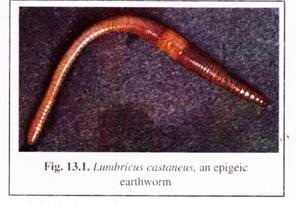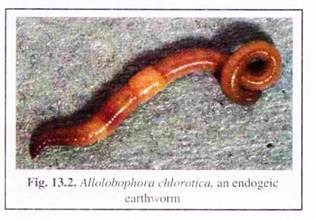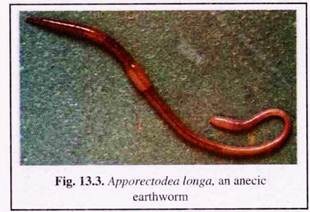In this article we will discuss about the suitable and non-suitable breeds for vermicomposting.
Suitable Breeds for Vermicomposting:
All earthworms are not suitable for vermicomposting. Only those that live on the soil surface and thrive on organic wastes are suitable. About 3627 species of earthworms have been identified in the world. Out of it only 3 to 5 per cent species are capable of vermicomposting.
Suitable worms for vermicomposting possess following characteristics:
1. The worm should exhibit high biomass consumption together with a high efficiency of conversion of ingested biomass to body proteins, a physiological trait required for achieving high growth rate.
ADVERTISEMENTS:
2. The worm should have wider range of tolerance to environmental factors including adaptation to feed on a variety of organic residues.
3. Worm should produce large number of cocoons at a time and should have rapid population growth.
4. Life cycle should consist a longer period for adults.
5. The worm should be disease resistant.
ADVERTISEMENTS:
The earthworm species most often used for composting is the Red Wiggler (Eisenia foetida or Eisenia andrei), European night crawlers (Eisenia hortensis), Red earthworm or dilong (China) (Lum- bricus rubellus), etc. Among these breeds red earthworm is less well adapted to the shallow compost bin than Eisenia. Blue worms (Perionyx excavatus) may be used in the tropics.
In India usually following earthworms are cultured for vermicomposting: Perionyx excavatus, Lampito mauritii, Drawida willsi, Polypheretima elongata, etc. These species are commonly found in organic- rich soils and live in rotting vegetation, compost, and manure piles. They may be an invasive species in some areas. As they are shallow-dwellers and feed on decomposing plant matter in the soil, they adapt easily to living on food or plant waste, in the confines of a worm bin.
Composting worms can be obtained through online order or from nursery mail-order suppliers or angling (fishing) shops where they are sold as bait. They can also be collected from compost and manure piles. These species are not the same worms that are found in ordinary soil or on pavement when the soil is flooded with water.
Classification of Earthworms on the Basis of their Habitat:
(a) Epigeic Earthworms:
ADVERTISEMENTS:
The earthworms which live on the surface of the soil in leaf litter are called epigeic earthworms. These species tend not to make burrows but live in and feed on the leaf litter. Epigeic earthworms are bright red or reddish-brown in colour, but they are not stripy.
Epigeic earthworm species include Dendrobaena octaedra, D. attemsi, Dendrodrilus rubidus, Eiseniella tetraedra, Heliodrilus oculatus, Lumbricus rubellus, L. castaneus (Fig. 13.1), L. festivus, L.fri- endi, Satchellius mammalis.
(b) Endogeic Earthworms:
The earthworms those make horizontal burrows through the soil to move around and to feed and reuse these burrows to a certain extent are called endogeic earthworms. Some can burrow very deeply in the soil. Endogeic earthworms live in and feed on the soil. These earthworms are pale grey, pale pink, green or blue coloured.
Endogeic earthworm species include Allolobo- phora chlorotica (Fig. 13.2), Apporectodea caligi- nosa, A. icterica, A. rosea, Murchieona muldali, Octolasion cyaneum and O. tyrtaeum
(c) Aneeic Earthworms:
The earthworms which make permanent vertical burrows in soil are called aneeic earthworms. They feed on leaves on the soil surface that they drag into their burrows. They also cast on the surface, and these casts can quite often be seen in grasslands.
ADVERTISEMENTS:
They also make middens (piles of casts) around the entrance to their burrows. Aneeic species are the largest species of earthworms. They are darkly coloured at the head end (red or brown) and have paler tails. Aneeic earthworm species include Lumbricus terrestris and Apporectodea longa (Fig. 13.3).
Non-Suitable Breeds for Vermicomposting:
Lumbricus terrestris [Night crawlers (US) or common earthworm (UK)] are not recommended as they burrow deeper than most compost bins can accommodate.
Perionyx excavatus worms are also not suitable for worm compost in bins, but scientists opine that this species is amongst the best suited for large scale vermicomposting in tropical climate, i.e., East &West Himalayan states, Pilibhit, Bengal and little Andaman islands.


